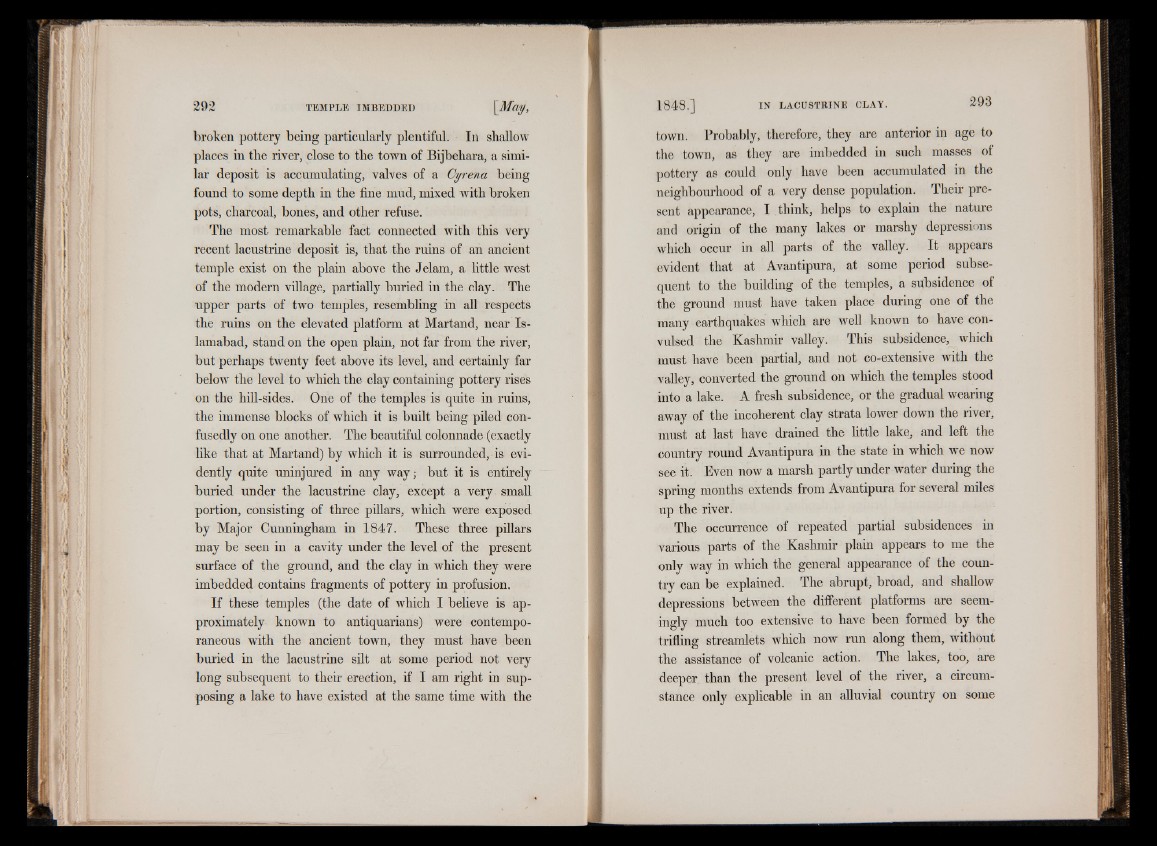
broken pottery being particularly plentiful. In shallow
places in the river, close to the town of Bijbehara, a similar
deposit is accumulating, valves of a Cyrena being
found to some depth in the fine mud, mixed with broken
pots, charcoal, bones, and other refuse.
The most remarkable fact connected with this very
recent lacustrine deposit is, that the ruins of an ancient
temple exist on the plain above the Jelam, a little west
of the modern village, partially buried in the clay. The
upper parts of two temples, resembling in all respects
the ruins on the elevated platform at Martand, near Islamabad,
stand on the open plain, not far from the river,
but perhaps twenty feet above its level, and certainly far
belowr the level to which the clay containing pottery rises
on the hill-sides. One of the temples is quite in ruins,
the immense blocks of which it is built being piled confusedly
on one another. The beautiful colonnade (exactly
like that at Martand) by which it is surrounded, is evidently
quite uninjured in any way; but it is entirely
buried under the lacustrine clay, except a very small
portion, consisting of three pillars, which were exposed
by Major Cunningham in 1847. These three pillars
may be seen in a cavity under the level of the present
surface of the ground, and the clay in which they were
imbedded contains fragments of pottery in profusion.
If these temples (the date of which I believe is approximately
known to antiquarians) were contemporaneous
with the ancient town, they must have been
buried in the lacustrine silt at some period not very
long subsequent to their erection, if I am right in supposing
a lake to have existed at the same time with the
town. Probably, therefore, they are anterior in age to
the town, as they are imbedded in such masses of
pottery as could only have been accumulated in the
neighbourhood of a very dense population. Their present
appearance, I . think, helps to explain the nature
and origin of the many lakes or marshy depressions
which occur in all parts of the valley. It appears
evident that at Avantipura, at some period subsequent
to the building of the temples, a subsidence of
the ground must have taken place during one of the
many earthquakes which are well known to have convulsed
the Kashmir valley. This subsidence, which
must have been partial, and not co-extensive with the
valley, converted the ground on which the temples stood
into a lake. A fresh subsidence, or the gradual wearing
away of the incoherent clay strata lower down the river,
must at last have drained the little lake, and left the
country round Avantipura in the state in which we now
see it. Even now a marsh partly under water during the
spring months extends from Avantipura for several miles
up the river.
The occurrence of repeated partial subsidences in
various parts of the Kashmir plain appears to me the
only way in which the general appearance of the country
can be explained. The abrupt, broad, and shallow
depressions between the different platforms are seemingly
much too extensive to have been formed by the
trifling streamlets which now run along them, without
the assistance of volcanic action. The lakes, too, are
deeper than the present level of the river, a circumstance
only explicable in an alluvial country on some